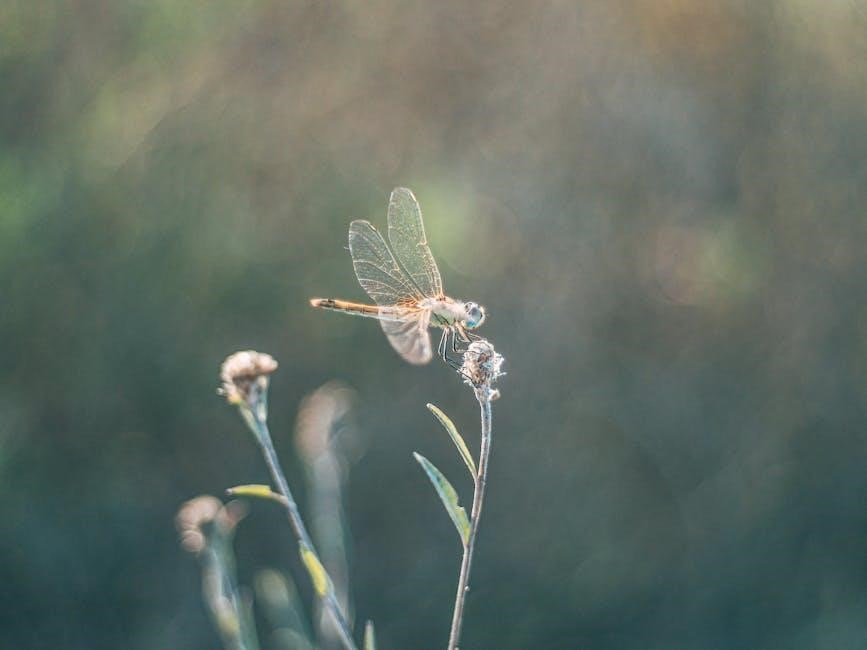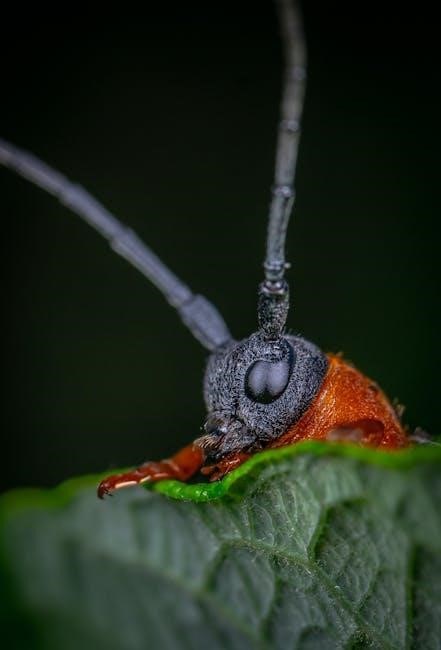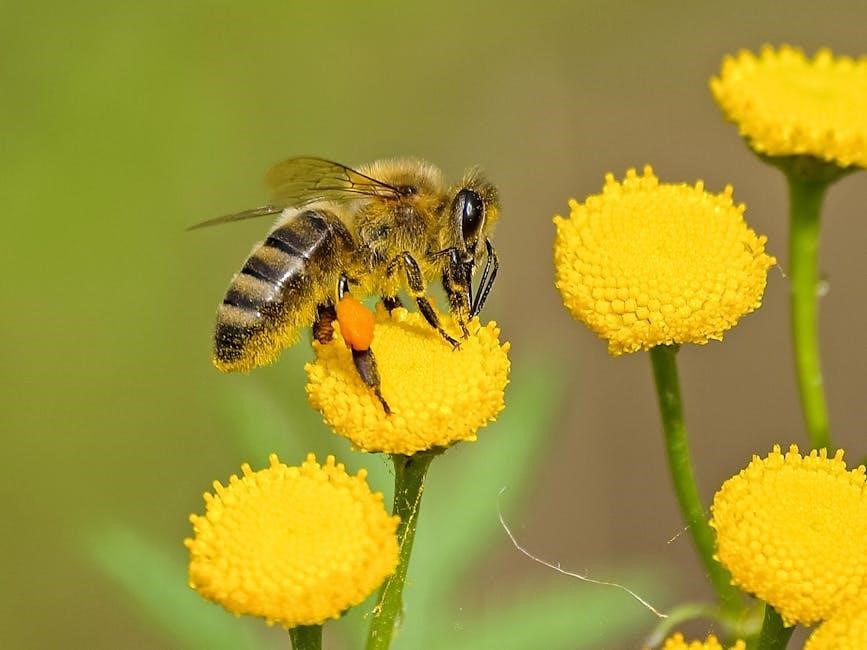Insect field guides provide essential information on various insect species,
including
their characteristics and habitats, helping users identify and understand insects in their natural environments effectively always.
Importance of Insect Identification
Insect identification is crucial for understanding the role of insects in ecosystems and their impact on human activities. Accurate identification of insects can help in detecting invasive species, pests, and diseases, which is essential for maintaining ecosystem balance and preventing economic losses.
According to various sources, insect identification can also contribute to the development of effective conservation strategies and management plans.
Furthermore, insect identification can facilitate research in fields such as ecology, biology, and entomology, leading to a better understanding of insect behavior, ecology, and evolution.
Additionally, insect identification can inform policy decisions related to agriculture, forestry, and public health, highlighting the need for accurate and reliable identification methods.
Overall, the importance of insect identification cannot be overstated, and its applications are diverse and far-reaching, making it a vital component of insect field guides and related resources.
Insect field guides play a critical role in facilitating insect identification by providing comprehensive information on insect characteristics, habitats, and distributions.
Specialized Taxonomic Keys
Specialized taxonomic keys are essential tools for insect identification, providing a systematic approach to identifying insect species. These keys are typically designed for specific groups of insects, such as beetles or flies, and are used to determine the identity of an unknown specimen.
According to entomologists, specialized taxonomic keys are often developed by experts in the field and are based on a thorough understanding of insect morphology and anatomy.
The development of specialized taxonomic keys involves a rigorous process of character analysis and testing, ensuring that the keys are accurate and reliable.
These keys are usually presented in a hierarchical format, with each character or trait leading to a series of choices that ultimately result in the identification of the insect species.
Specialized taxonomic keys are widely used in insect field guides and are considered an essential resource for entomologists, researchers, and students of entomology.
The use of specialized taxonomic keys requires a good understanding of insect biology and morphology, as well as practice and experience in using the keys effectively.

Insect Field Guides for North America

Insect field guides for North America provide valuable information on insect species, including identification and habitats, using
regional
data and expert knowledge always effectively online.
Main Insect Field Guides
Main insect field guides are comprehensive resources that provide detailed information on various insect species, including their characteristics, habitats, and behaviors. These guides are often written by experts in the field and are designed to be user-friendly, making them accessible to both professionals and amateurs. The main insect field guides typically cover a wide range of topics, including insect identification, life cycles, and conservation status. They may also include photographs, illustrations, and distribution maps to help users visualize and understand the different species. Some of the most well-known main insect field guides include the Peterson Field Guide to Insects and the National Audubon Society Field Guide to Insects and Spiders. These guides are widely used by entomologists, naturalists, and educators, and are considered essential tools for anyone interested in learning about insects. By using these guides, users can gain a deeper understanding of the natural world and develop a greater appreciation for the diversity of insect life. Overall, main insect field guides are invaluable resources for anyone interested in insects and their role in the ecosystem; They provide a wealth of information and are an essential tool for anyone looking to learn more about these fascinating creatures.
Field Crop Insects Guide

The Field Crop Insects Guide is a valuable resource for farmers, agronomists, and crop scouts, providing detailed information on insects that affect field crops. This guide includes descriptions and photos of over 50 pest and beneficial insects found in Iowa, as well as information on their life cycles, damage, and management options; The guide is designed to help users identify insects and develop effective management strategies to minimize crop damage. It covers a range of topics, including insect identification, monitoring techniques, and control options, including biological and cultural controls. The guide is regularly updated to reflect the latest research and management recommendations, making it a trusted resource for those working in agriculture. By using the Field Crop Insects Guide, farmers and agronomists can make informed decisions about pest management, reducing the risk of crop damage and minimizing the use of chemical pesticides. This guide is an essential tool for anyone involved in field crop production, helping to promote sustainable and effective crop management practices. It is a valuable addition to any agricultural library, providing a wealth of information on field crop insects;

Insect Identification Characteristics
Insect characteristics include body segments, legs, and wings, with
specific
features used to identify species and categorize insects effectively always online.
Diagnostic Characteristics
Diagnostic characteristics are essential for accurate insect identification, and they include physical features such as body shape, size, color, and pattern. These characteristics can be used to distinguish between different species and families of insects. The use of diagnostic characteristics in insect identification is crucial, as it allows for the accurate classification of insects into their respective groups. Insect field guides often provide detailed descriptions and illustrations of these characteristics, making it easier for users to identify insects. The characteristics may include the shape and structure of the insect’s body, the number and arrangement of legs, the type and color of wings, and other distinctive features. By examining these characteristics, users can narrow down the possibilities and make a more informed identification. This approach is particularly useful when dealing with similar-looking species, where small differences in diagnostic characteristics can be used to distinguish between them. Overall, the use of diagnostic characteristics is a fundamental aspect of insect identification and is widely used in insect field guides.
Life Cycle and Behavior
Insect field guides often include information on the life cycle and behavior of various insect species, which is essential for understanding their ecology and biology. The life cycle of an insect typically includes several stages, such as egg, larva, pupa, and adult, each with distinct characteristics and behaviors. Understanding these stages and behaviors can help users identify insects and appreciate their role in the ecosystem. Insect behavior, such as feeding habits, mating rituals, and social interactions, can also be fascinating and informative. By studying the life cycle and behavior of insects, users can gain a deeper appreciation for the complexity and diversity of insect life. This information can also be useful for managing insect populations, whether for conservation or pest control purposes. Overall, the study of life cycle and behavior is an important aspect of insect field guides, providing valuable insights into the biology and ecology of insects. This knowledge can be used to inform conservation efforts and promote a greater understanding of the natural world.